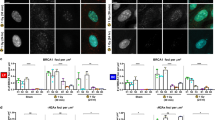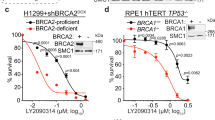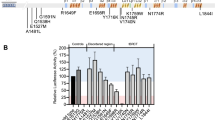Abstract
We analyzed the effects of 14 different missense mutations in the RING domain of BRCA1 on the function of the protein in the control of centrosome number in tissue culture cells. Whereas 2 of the 14 BRCA1 variant proteins were neutral in the centrosome duplication assay, missense mutations of zinc-coordinating residues (C24R, C27A, C39Y, H41F, C44F and C47G) and mutations encoding BRCA1 variants M18T and I42V resulted in BRCA1 proteins that caused centrosome amplification. BRCA1 variant proteins I21V, I31M, L52F and D67Y had an intermediate effect on centrosome duplication. In addition, one of the variants, L52F, caused a peculiar phenotype with amplified centrosomes but the centrioles remained paired. By comparison, other BRCA1 variants that caused centrosome amplification had clustering of supernumerary centrosomes with unpaired centrioles. This surprising phenotype suggests that the BRCA1 protein regulates two functions in the control of centrosome duplication: regulation of centrosome number and regulation of centriole pairing. The L52F is unusual as it is defective in only one of these processes. This study analyzes the function of BRCA1 missense mutations in the control of centrosome duplication, a critical step in the maintenance of genetic stability of mammary epithelial cells, and indicates a new function of BRCA1 in the control of centriole pairing.
This is a preview of subscription content, access via your institution
Access options
Subscribe to this journal
Receive 50 print issues and online access
$259.00 per year
only $5.18 per issue
Buy this article
- Purchase on Springer Link
- Instant access to full article PDF
Prices may be subject to local taxes which are calculated during checkout


Similar content being viewed by others
Accession codes
References
Brzovic PS, Keeffe JR, Nishikawa H, Miyamoto K, Fox III D, Fukuda M et al. (2003). Binding and recognition in the assembly of an active BRCA1/BARD1 ubiquitin-ligase complex. Proc Natl Acad Sci USA 100: 5646–5651.
Chapman MS, Verma IM . (1996). Transcriptional activation by BRCA1. Nature 382: 678–679.
Chiba N, Parvin JD . (2002). The BRCA1 and BARD1 association with the RNA polymerase II holoenzyme. Cancer Res 62: 4222–4228.
D'Assoro AB, Stivala F, Barrett S, Ferrigno G, Salisbury JL . (2001). GFP-centrin as a marker for centriole dynamics in the human breast cancer cell line MCF-7. Ital J Anat Embryol 106: 103–110.
Easton DF, Deffenbaugh AM, Pruss D, Frye C, Wenstrup RJ, Allen-Brady K et al. (2007). A systematic genetic assessment of 1433 sequence variants of unknown clinical significance in the BRCA1 and BRCA2 breast cancer-predisposition genes. Am J Hum Genet 81: 873–883.
Haile DT, Parvin JD . (1999). Activation of transcription in vitro by the BRCA1 carboxyl-terminal domain. J Biol Chem 274: 2113–2117.
Houvras Y, Benezra M, Zhang H, Manfredi JJ, Weber BL, Licht JD . (2000). BRCA1 physically and functionally interacts with ATF1. J Biol Chem 275: 36230–36237.
Jensen DE, Proctor M, Marquis ST, Gardner HP, Ha SI, Chodosh LA et al. (1998). BAP1: a novel ubiquitin hydrolase which binds to the BRCA1 RING finger and enhances BRCA1-mediated cell growth suppression. Oncogene 16: 1097–1112.
Kais Z, Parvin JD . (2008). Regulation of centrosomes by the BRCA1-dependent ubiquitin ligase. Cancer Biol Ther 7: 1540–1543.
MacLachlan TK, Somasundaram K, Sgagias M, Shifman Y, Muschel RJ, Cowan KH et al. (2000). BRCA1 effects on the cell cycle and the DNA damage response are linked to altered gene expression. J Biol Chem 275: 2777–2785.
Miki Y, Swensen J, Shattuck-Eidens D, Futreal PA, Harshman K, Tavtigian S et al. (1994). A strong candidate for the breast and ovarian cancer susceptibility gene BRCA1. Science 266: 66–71.
Monteiro AN, August A, Hanafusa H . (1996). Evidence for a transcriptional activation function of BRCA1 C-terminal region. Proc Natl Acad Sci USA 93: 13595–13599.
Morris JR, Pangon L, Boutell C, Katagiri T, Keep NH, Solomon E . (2006). Genetic analysis of BRCA1 ubiquitin ligase activity and its relationship to breast cancer susceptibility. Hum Mol Genet 15: 599–606.
Moynahan ME, Chiu JW, Koller BH, Jasin M . (1999). Brca1 controls homology-directed DNA repair. Mol Cell 4: 511–518.
Nigg EA . (2002). Centrosome aberrations: cause or consequence of cancer progression? Nat Rev Cancer 2: 815–825.
Pao GM, Janknecht R, Ruffner H, Hunter T, Verma IM . (2000). CBP/p300 interact with and function as transcriptional coactivators of BRCA1. Proc Natl Acad Sci USA 97: 1020–1025.
Ransburgh DJ, Chiba N, Ishioka C, Toland AE, Parvin JD . (2010). Identification of breast tumor mutations in BRCA1 that abolish its function in homologous DNA recombination. Cancer Res 70: 988–995.
Ruffner H, Joazeiro CA, Hemmati D, Hunter T, Verma IM . (2001). Cancer-predisposing mutations within the RING domain of BRCA1: loss of ubiquitin protein ligase activity and protection from radiation hypersensitivity. Proc Natl Acad Sci USA 98: 5134–5139.
Sankaran S, Crone DE, Palazzo RE, Parvin JD . (2007). BRCA1 regulates gamma-tubulin binding to centrosomes. Cancer Biol Ther 6: 1853–1857.
Scully R, Anderson SF, Chao DM, Wei W, Ye L, Young RA et al. (1997). BRCA1 is a component of the RNA polymerase II holoenzyme. Proc Natl Acad Sci USA 94: 5605–5610.
Sinilnikova OM, Mazoyer S, Bonnardel C, Lynch HT, Narod SA, Lenoir GM . (2006). BRCA1 and BRCA2 mutations in breast and ovarian cancer syndrome: reflection on the Creighton University historical series of high risk families. Fam Cancer 5: 15–20.
Sluder G, Nordberg JJ . (2004). The good, the bad and the ugly: the practical consequences of centrosome amplification. Curr Opin Cell Biol 16: 49–54.
Starita LM, Machida Y, Sankaran S, Elias JE, Griffin K, Schlegel BP et al. (2004). BRCA1-dependent ubiquitination of gamma-tubulin regulates centrosome number. Mol Cell Biol 24: 8457–8466.
Vega A, Campos B, Bressac-De-Paillerets B, Bond PM, Janin N, Douglas FS et al. (2001). The R71G BRCA1 is a founder Spanish mutation and leads to aberrant splicing of the transcript. Hum Mutat 17: 520–521.
Wu LC, Wang ZW, Tsan JT, Spillman MA, Phung A, Xu XL et al. (1996). Identification of a RING protein that can interact in vivo with the BRCA1 gene product. Nat Genet 14: 430–440.
Xu X, Weaver Z, Linke SP, Li C, Gotay J, Wang XW et al. (1999). Centrosome amplification and a defective G2-M cell cycle checkpoint induce genetic instability in BRCA1 exon 11 isoform-deficient cells. Mol Cell 3: 389–395.
Acknowledgements
This work was supported by NIH Grant CA111480 (JDP).
Author information
Authors and Affiliations
Corresponding author
Ethics declarations
Competing interests
The authors report no conflict of interest.
Additional information
Supplementary Information accompanies the paper on the Oncogene website
Supplementary information
Rights and permissions
About this article
Cite this article
Kais, Z., Chiba, N., Ishioka, C. et al. Functional differences among BRCA1 missense mutations in the control of centrosome duplication. Oncogene 31, 799–804 (2012). https://doi.org/10.1038/onc.2011.271
Received:
Revised:
Accepted:
Published:
Issue Date:
DOI: https://doi.org/10.1038/onc.2011.271
Keywords
This article is cited by
-
Pathogenic BRCA1 variants disrupt PLK1-regulation of mitotic spindle orientation
Nature Communications (2022)
-
In-Silico Analyses of Nonsynonymous Variants in the BRCA1 Gene
Biochemical Genetics (2021)
-
Contribution of BRCA1 and BRCA2 germline mutations to early onset breast cancer: a series from north of Morocco
BMC Cancer (2020)
-
Novel mutations in actionable breast cancer genes by targeted sequencing in an ethnically homogenous cohort
BMC Medical Genetics (2019)
-
RACK1 regulates centriole duplication by controlling localization of BRCA1 to the centrosome in mammary tissue-derived cells
Oncogene (2019)



